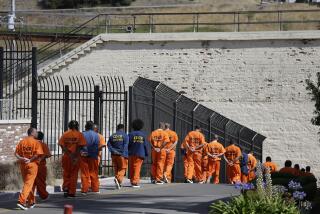No Mercy--and Rightly So--for Rapist : The case, in which a child molester received 122 years, points up problems that must be solved
- Share via
Los Angeles Superior Court Judge Ronald S. Coen has brought a fitting close to one part of the case of Robert Lee Donaldson--convicted rapist and child molester. Donaldson had been convicted Aug. 7 on 18 felony counts of stalking, raping and threatening to kill three girls. All three of the victims, ages 11 through 16, had been attacked as they walked alone to school in Pacoima and Inglewood.
Judge Coen rightly rejected a defense plea for mercy in sentencing Donaldson to 122 years in state prison, almost ensuring that he will spend the rest of his life behind bars.
“He has stalked his victims like a piranha and attacked them without mercy,” Judge Coen said. “As a parent, I am offended. As a judge, I am outraged.”
The young victims will not soon forget their ordeal, and neither should the rest of us. This case brought too many important problems to light, and they must be addressed point by point.
* A flaw in the system:
First, we hope that parole officials keep this case in mind when dealing with similar offenders. By the age of 18, Donaldson had already been convicted of attempted murder. Within 10 months of his 1980 release, he had been convicted of robbery. By 1982, he had raped and sodomized three young boys in Pacoima and was later sent to prison. Because of the California criminal justice system’s shift in emphasis from treatment to imprisonment in such cases, all Donaldson needed to demonstrate was good behavior. He was automatically paroled without a hearing after 9 1/2 years, in 1993. He then went back to the very same block in Pacoima to commit some of his final crimes against young girls.
* Woeful investigative capacity:
The Donaldson case also brought attention to the fact that the Los Angeles Police Department had been trying for years to establish a computerized tracking system that would allow detectives to monitor repeat sex offenders and determine likely suspects. It was another significant indication of the fact that the LAPD did not have the funding to deal with reasonable crime-fighting demands.
* The vulnerability of children:
If anyone still believed that much of the San Fernando Valley was immune to the types of problems that plague schoolchildren in drug-ridden and gang-controlled neighborhoods, the Donaldson case shattered that notion.
One of the better ideas to have come out on the matter was the idea of creating a system of so-called “Safe Havens.” These were to be clearly marked homes where children could find refuge if approached by strangers. The need for this program remains. Now, we wonder, who among our elected officials, will step forward to get the job under way.
More to Read
Sign up for Essential California
The most important California stories and recommendations in your inbox every morning.
You may occasionally receive promotional content from the Los Angeles Times.













